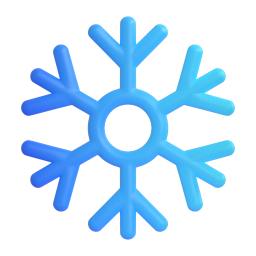❄️ Snowflake
The unique, feathery ice crystal of a snowflake. Depicted as a bluish-white snowflake with six intricate symmetrical branches. Like 🌨️ Cloud With Snow, may be used as a weather icon to represent a snowstorm or a cold, snowy day. May also be used for various content concerning wintertime, cold climates, and winter activity, such as skiing. Sometimes used as an insult to call a person weak and oversensitive.
❄️
❄️ Snowflake
Also known as: Snow, Snowing
Unicode: U+2744, U+FE0F
Image Variants

3D
Color
Flat
High Contrast
Version Information
Emoji Version:1.0
Unicode Version:1.1
Keywords
coldsnowsnowflake
Shortcodes
| Platform | Shortcode | Action |
|---|---|---|
| Emojipedia | :snowflake: |
Additional Information
Category:Dingbats -> Stars, asterisks and snowflakes
Definition:
Snow falling to the ground in the form of a unique ? snowflake. With enough snow, a snowman can be made! Snow found at alpine resorts and mo http://emojipedia.org/snowflake/
Adjectives:
- Having a low or inadequate temperature or feeling a sensation of coldness or having been made cold by e.g. ice or refrigeration
- Having a low temperature.
- Marked by the presence of snow
- Marked by the presence of snow.
- Resembling snow.
- Cold and icy
- Extremely cold
- Extremely cold, snowy, or having other properties of extreme winter associated with the Arctic.
- Cold, snowy, or having other properties of extreme winter associated with the Arctic.
- Very cold; icy or frosty.
- Being extremely cold, snowy, or having other properties of extreme winter associated with the Arctic.
Verbs:
- To fall from the clouds in the form of ice crystals.
- To have snow fall from the sky.
- Have snow fall from the sky.
- Fall as snow
Nouns:
- Winter is the coldest season of the year in polar climates and temperate climates, between autumn and spring.
- The coldest season of the year; in the northern hemisphere it extends from the winter solstice to the vernal equinox
- The coldest season of the year in temperate climates
- The season of winter, between autumn and spring
- Winter is one of the four seasons of temperate zones.
- Fourth season, marked by short days and lowest temperatures.
- Traditionally the fourth of the four seasons, typically regarded as being from December 23 to March 20 in continental regions of the Northern Hemisphere or the months of June, July and August in the Southern Hemisphere. It is the time when the sun is lowest in the sky, resulting in short days, and the time of year with the lowest atmospheric temperatures for the region.
- Traditionally, the fourth of the seasons, marked by the applicable hemisphere of the planet being at its minimum angle of exposure to the Sun, resulting in short days, long nights and typically in low temperatures.
- One of the four seasons, between autumn and spring
- A snow system leading to an accumulation of snow between 1 to 3 inches. A snow shower brings more snow than a flurry, but less than a snow storm or a blizzard.
- Precipitation falling from clouds in the form of ice crystals
- Snow is so much more than a type of precipitation in the form of crystalline water ice, consisting of a multitude of snowflakes that fall from clouds, but complicates and blesses our lives in a number of ways, giving rise to both frustration and romance.

